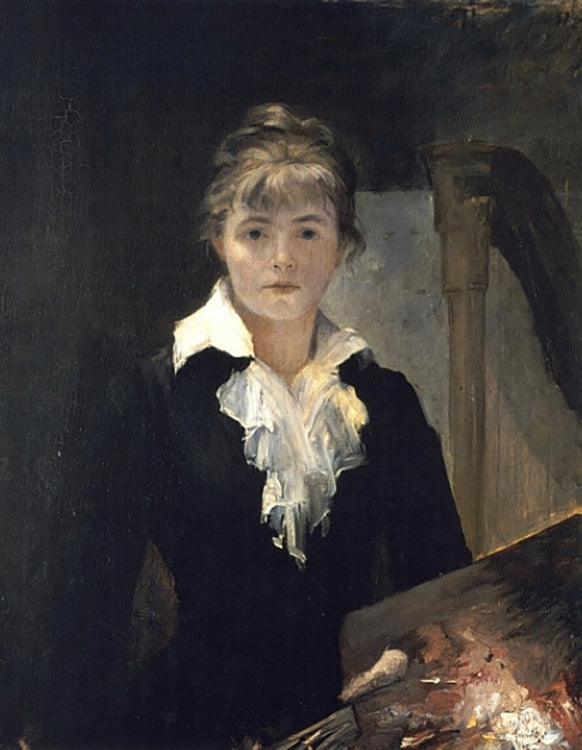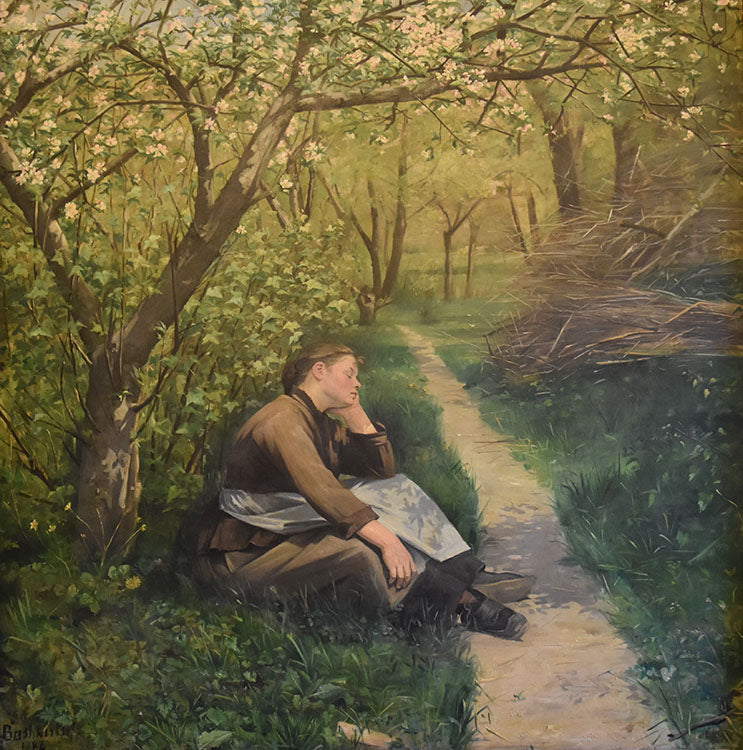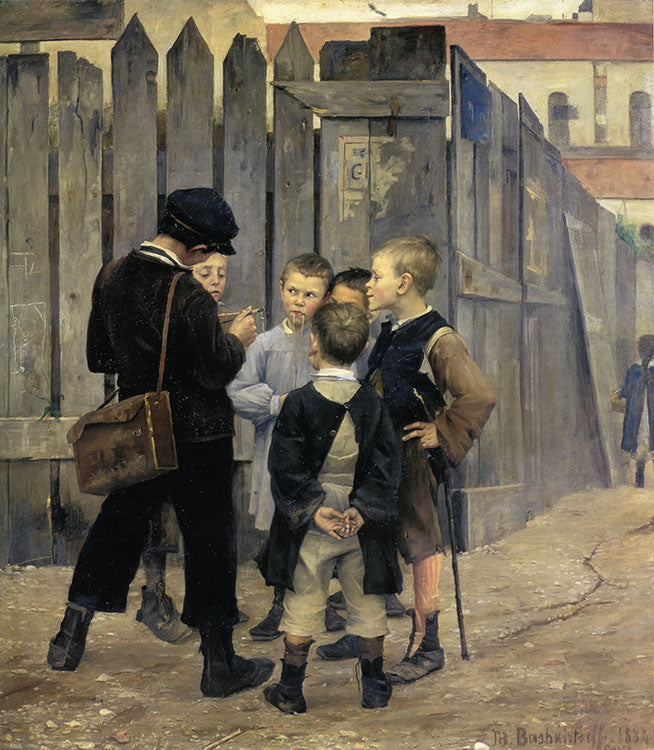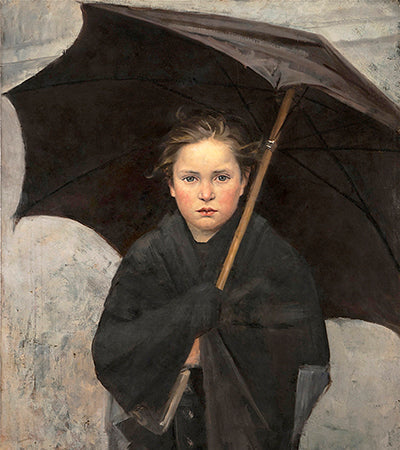
Marie Bashkirtseff, "Self-portrait with a Palette" (1880), oil on canvas. Collection of Musée des Beaux-Arts de Nice (Jules Chéret), Nice, France.
Reflections on a Genius: Marie Bashkirtseff
by Joel L. Schiff
Note: Some excerpts in this article have been taken from the book by the author listed in the Bibliography. Unattributed quotes are from Marie’s Journal.A fortune teller once told Maria Bashkirtseff that her son would be ordinary but her daughter, Marie, would be a star. And indeed Marie’s life did become that of a dazzling light shooting across the firmament of human existence. Her Journal of more than a century ago, translated into multiple languages and still read today, reveals a woman who was vain, egotistical, melodramatic, envious, and jealous. But she was also an intellectual, a feminist, a very fine artist, and at times she thought herself a genius, which perhaps she was.
My relatives haven’t committed any crime except to be born stupid!
Marie Bashkirtseff (1858-1884) was one of the most extraordinary women of the 19th century. Her Journal, originally comprising some 20,000 hand-written pages but pared down to a few hundred for publication, was a cause célèbre after her death in 1884, and continues to be an inspiration to the Women’s Movement to this day. It also inspired such great writers as Anaïs Nin, Katherine Mansfield, the suffragette Kate Parry Frye, and Mary MacLane (‘the Butte Bashkirtseff’), among others. Indeed, The Story of Mary MacLane (1902) sold 100,000 copies in America in its first month.
One of four English translators of Marie’s journals, Mary J. Serrano, met her subject on a single occasion. It was a revelation:
At this moment Mlle. Bashkirtseff appeared. I saw her but once. I saw her only for an hour. I shall never forget her. Twenty-three years old, but she appeared much younger. Rather short, but with a perfect figure; an oval face exquisitely modeled, golden hair, dark eyes kindling with intelligence – eyes consumed by the desire to see and to know everything – a firm mouth, tender and thoughtful; nostrils quivering like those of a wild horse of the Ukraine.
At the first glance Mlle. Bashkirtseff gave me the rare impression of being possessed of strength in gentleness, dignity in grace. Everything in this adorable young girl betrayed a superior mind. Beneath her womanly charms, she had a truly masculine will of iron, and one was reminded of the gift of Ulysses to the young Achilles – a sword hidden within the garments of a woman.…
Born into an aristocratic family in a village in Ukraine the family soon settled in France, first in Nice and later in Paris. Taught entirely by tutors and through self-study, this young woman of noble birth with the golden-red hair and gray eyes learned English, German, Italian, Latin, and Greek, as well as drawing. Mastering several musical instruments she longed for a singing career on the stage. An illness (likely from incipient tuberculosis) that affected her throat made her change course and she took up painting for which she had a latent talent.
Probably the pre-eminent school for art instruction in the world was the École des Beaux-Arts in Paris, but it did not accept women in Marie’s time. Only 249 years after its founding in 1648 did it deem women worthy of artistic tuition.

Photo of Marie Bashkirtseff, Walery, Paris (1875). Musée des Beaux-Arts, Nice.
However, the Académie Julian, in Paris did accept women and moreover employed some of the same teachers as the École des Beaux-Arts, such academic masters as Adolphe-William Bouguereau, Jean-Paul Laurens, Tony Robert-Fleury, Gustave Boulanger, Jules Lefebvre… The Julian also took men pupils and the likes of Henri Matisse, Pierre Bonnard, Jacques Lipschitz, and John Singer Sargent also passed through its doors. To this esteemed list was added the name of Marie Bashkirtseff in 1877. Such was her talent that within a few short years under the wing of Robert-Fleury, Marie was exhibiting at the annual Paris Salon, the premier venue for artists of the day, and winning distinction for her work as a painter of French réalisme.
But it was her personality that makes Marie Bashkirtseff such an exceptional individual. At a very young age she was already exhibiting in her Journal the thoughts of a learned philosopher, wrestling with the nature of God, the position of women in society, the politics of men. Having contracted tuberculosis at a young age she ceaselessly strove to shrug it off in her quest to achieve Greatness. In the end, a great tragedy unfolded with Marie and the naturalist artist Jules Bastien-Lepage virtually dying in each other’s arms. She from the TB and he from stomach cancer.
I hide a mystery; death has touched me with its finger.
Marie began her Journal in January 1873 when she was but fourteen years of age. Her raison d’être for writing it was that she should be remembered as someone who lived fervently and passionately. And without question, she did.
In the words of another Journal translator Mathilde Blind, Marie’s Journal depicts ‘the drama of a woman’s soul … [of] a girl with the ambition of a Caesar.’ Four-time Prime Minister of Britain, William Gladstone, called the Journal ‘A book without parallel.’ Who but Marie could write the following with such poignancy age seventeen:
To think only that we live but once, and that this life is so short! When I think of this my senses forsake me and my mind becomes a prey to despair! We live but once! And I am losing this precious life, hidden in obscurity, seeing no one. We live but once! And my life is being ruined. We live but once! And I am made to waste my time miserably. And the days are passing, passing, never to return, and carrying a part of my life with them, as they pass.
We live but once! Must this life, already so short, be still further shortened, ruined, stolen – yes stolen – by miserable circumstances?

As a fervent admirer of Jules Bastien-Lepage, Marie took to the streets of Paris. This is her painting titled "Jean et Jacques" (1883), oil on canvas, exhibited at the Paris Salon. Courtesy the Newberry Library, Chicago, USA.
Given Marie’s fertile, questioning mind, it is only natural that she became incensed by the injustices accorded her sex. She wrote incisive pieces for the French feminist monthly La Citoyenne and corresponded with the eminent French writer Guy de Maupassant. The latter and Marie exchanged a series of perplexing letters and in the end de Maupassant perhaps realizing that he had met his match, signs off his final missive with, “I kiss your hands, Madame.”
Mary Louise Breakell (1856-1931) was an art student contemporary of Marie’s at the Julian Académie. Their choice of subject matter was similar, namely, figure, genre, and floral works. After training at Julian’s, Mary lived in Manchester and London, and exhibited at many important English venues including the Royal Academy.
Although we think of Marie Bashkirtseff and Mary Breakell being from a bygone era, the latter’s book on watercolor painting (1904) was reproduced in 2013, the same year as the excellent translation of Marie’s Journal by Katherine Kernberger. So, they are both still very much with us to this day.

A portion of Marie's painting: "Le Parapluie (The Umbrella)" (1883), oil on canvas, on the cover of a recent edition of Les Misérables. Original (right) courtesy of the State Russian Museum, St. Petersburg, Russia.
At one stage, M. Julian requested that both Marie and fellow student Amélie Beaury-Saurel (1856-1924) each paint a work of the atelier, perhaps to use as an advertisement for his academy. Mary Breakell some 20 years later vividly recalled the occasion:
We are all chattering in harmonious European concert when the door flies open, and with a flutter and a rustle and a cheerful, ringing, ‘Bon jour, Mesdames’ enters ‘the Russian.’ She impatiently unfastens, flings back her costly furs and long silk mantle; right regally she lets them fall to the bare, boarded floor, for the bonne to pick up. Clothes to her are non-existent at the moment (or she would have us think so). She is conscious only of Art and the great picture, which is a picture of Us, the European concert, harmoniously ‘painting the Life’ together…
We are huddled by each other's easels, cribbed, cabined, and confined in the smallest of possible spaces, in the larger interests of Russia, represented by Marie, on the one hand, and of Spain, by Mlle. Amélie, on the other.

Marie Bashkirtseff, "L’Atelier Julian" (1881), oil on canvas, exhibited at the Paris Salon 1881.
Marie painted herself into the work at the bottom right. This is the image that comes up on Google when you search for the Académie Julian.
So M. Julian got his advertising after all! Courtesy Museum of Fine arts, Dnepropetrovsk, Ukraine.
Amélie became a very fine artist in her own right winning a Third Medal at the Salon in 1885 and a bronze medal at the 1889 World’s Fair in Paris. She became good friends with Marie during their overlapping time at the Julian and went on to marry the boss, M. Julian in 1895.

Amélie Beaury-Saurel, “Dans Le Bleu” (1894), pastel. Courtesy Musée des Augustins de Toulouse.
Breakell further goes on to say that Marie was always on the ‘brink of passion’, but incapable of giving love, only able to absorb it from others.
Let us love dogs; let us love only dogs. Men and cats are unworthy creatures.
What are we to make of this? Firstly, it must be recognized that Marie was not at liberty as other women to give freely of her heart. Because of her intellect, and learning, Marie’s existence was on an elevated plane that constrained her unlike other women who passionately gave their hearts to the men who courted them, thus leaving very few men qualified to be a suitable husband. As expressed in her Journal Marie knew this very well, and therefore had to withhold sentiments of deep passion and love for someone who could truly meet her extraordinary requirements. Early admirers served merely as practice for the young Marie, whereas the French Bonapartist politician Cassagnac had captured her imagination but was perhaps too volatile and was himself toying with her. And so it would take someone like the towering statesman Léon Gambetta for Marie to fulfill a suitable grand passion. Yet this was not to be.
Marie’s situation was much like that of the character of Zenaida in Turgenev’s novella, First Love:
Perhaps you think that I love him? … No, I cannot love people whom I find that I look down on. I need someone who would himself master me, but then goodness me, I shall never come across anyone like that. I will never fall into anybody’s clutches, never, never.
But yes, Marie was a master of coquetry and employed it with devastating effect. Upon parting from discussion with the Polish Count Merjewsky, Marie requests, “I need to put on my coat. Can you arrange my hair over my collar?” This was the master at her flirtatious best and of course the poor Count was smitten. But is this such unusual behavior for a beautiful, intelligent young woman who was pursued by numerous members of the opposite sex? Perhaps Mary Breakell was not similarly pursued by men and her judgments were clouded by a sense of jealousy. But to her credit, Breakell does understand the feminine exterior, masculine interior that Marie herself often gave voice to in her Journals.
All men are scoundrels; a woman must change them as she changes her gloves.
A refreshing contrast with all the preceding tortured relationships with men is Marie’s amicable connection with her good friend Prince Bojidar Karageorgevitch who calls Marie, ‘... the best and most intelligent of women, the rare soul to whose advice I owe nearly all the good fortune I have had in my life.’ Bojidar Karageorgevitch was the son of Prince George Karageorgevitch, the pretender to the Serbian throne. Bojidar was certainly very fond of Marie who claimed that he was in love with her. Perhaps he was as a great many men were. Dare I say, even this author.

Marie Bashkirtseff, “Prince Bojidar Karageorgevitch” (1883), oil on canvas. Courtesy Serbian State Museum, Belgrade, Serbia.
In another area, Breakell’s assessment of Marie would agree with her own, that is, she felt that Marie was ‘a writer first, a painter last’, that she was ‘a philosopher, a thinker ... and fired by the inspiration of her native country, [could] become, perhaps, Russia’s great woman-novelist.’ This is very close to Marie’s own assessment:
I have begun to understand painting, but this is after much study and many efforts. Whereas I understand literature the instant that I open the book and read ... I understand the tricks of the trade, the way [fellow Julian student] Breslau must catch the same thing in painting. Then what am I waiting for?
Ironically, for once Breakell has taken a higher view of Marie’s potential than Marie herself. Breakell could see her as a female Tolstoy and yet Marie’s literary aspirations were to be a newspaper journalist. Nevertheless, Marie did achieve literary acclaim with her Journal, in no small measure because she was ‘a philosopher, a thinker’, and she was astute enough early on to appreciate its importance as a literary work. And it is upon the merits of her Journal that her fame is based, being the literary sensation in the 1890s that it was and such an inspiration for women ever since.
Marie’s last moments were recorded by her friend Bojidar who was by her bedside at the end:
Marie rises a bit, releases a soft sigh, the sigh of tiny children when waking, and two thick tears roll down her cheek ... then her head falls again into the pillow.
******
Young ... full of life, in all the fire and energy of unbroken human will,
she determined, though a woman, to conquer that Kingdom of Art
which showed itself so incredulous of a woman's gifts and powers.
But cold Death, indomitable, despite the radiant girl’s young life,
interposed this barrier – a wall which would not fall
at her behest, though blasted by youth,
with fire of beauty, gold, and genius.
And Death prevailed...
– Mary L. Breakell
Bibliography
Blind, Mathilde, translator: The Journal of Marie Bashkirtseff, Cassell & Co., 1890.
Breakell, Mary L., Marie Bashkirtseff: The Reminiscence of a Fellow Student, The Nineteenth Century and After, Leonard Scott Publ. Co., New York, Vol. 62, 1907, p.110-125.
Karageorgevitch, Bojidar, The Legend and Marie Bashkirtseff, Fortnightly Review 74 (July-December 1903): 647-653.
Hill, Ann, translator: I Kiss Your Hands – The letters of Guy de Maupassant and Marie Bashkirtseff, Rodale Press, 1954.
Kernberger, Katherine, translator: The Journal of Marie Bashkirtseff, Fonthill Press, 2012.
Schiff, Joel L., Portrait of Young Genius – The Life and Art of Marie Bashkirtseff, Vernon Press, 2018.
Serrano, Mary J., translator: Marie Bashkirtseff – The Journal of a Young Artist, Cassell & Co., New York, 1889.
About the Author
Joel L. Schiff was born in Chicago and has a PhD in mathematics from the University of California, Los Angeles. He spent his career at the University of Auckland and has written three books on various mathematical subjects (published by Springer-Verlag and John Wiley & Sons). He has also been a successful part-time asteroid hunter and was the founder/publisher of an international journal on Meteorites.
Having a life long interest in art, he is also an artist who paints in oils and in 2014 had a book published about the New Zealand/ Australian/British artist, Grace Joel. Research revealed that Ms Joel (no relation) studied at the well known Académie Julian in Paris and it was then that the author discovered another Julian student, Marie Bashkirtseff, one of the most fascinating individuals of the 19th century. His obsession with her led to the publication of the book: Portrait of Young Genius - The Life and Art of Marie Bashkirtseff, Vernon Press, 2017.
Other interests, such as orchid growing for more than 30 years has resulted in the book: Rare and Exotic Orchids (Springer - 2018). His pursuits in astronomy has compelled him to write a book on The Most Interesting Galaxies in the Universe to be published by IOP Science also in 2018.






